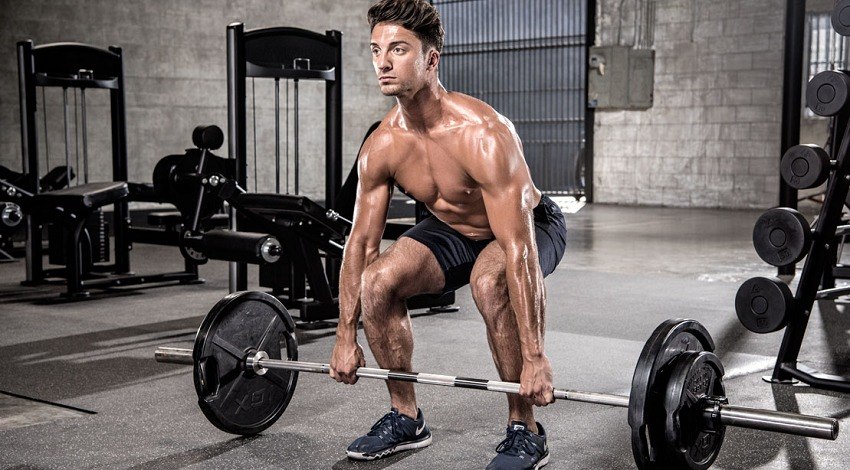Weight trainers: 6 exercises for maximum gains
 Health & Fitness
Health & Fitness
1) SQUATS
The squat is the cornerstone of any solid strength workout. It develops strength in the quads, glutes, lower back and abdominals. In fact, its been documented that squats activate over 200 muscles in the body.
When doing squats, always emphasize technique over weight lifted. 10 body weight squats are far more effective than 10 185 lb. squats done with poor technique. Instead of working the intended muscle, every rep performed with incorrect form actually makes us more likely to injure ourselves.
In the case of squats the injuries are typically to the low back and knees. Perfect it by focusing on hip movement, getting thighs parallel to the floor, keeping your weight to the rear of your foot (off toes) and not letting knees go beyond line of toes.
2) DEADLIFTS
Deadlifts are another exercise that many people either avoid or do incorrectly. 70% of people neglect the posterior chain group of muscles as they aren’t as visible as the muscles on the front of the body.
The squat is the cornerstone of any solid strength workout. It develops strength in the quads, glutes, lower back and abdominals. In fact, its been documented that squats activate over 200 muscles in the body.
When done with proper technique, deadlifts dramatically increase strength and stability of the posterior chain (glutes, hamstrings, lower back, lats) as well as the abdominals. People often will say they can’t do deadlifts as it hurts their back. Incorrect. POOR deadlifts hurt backs; PROPER deadlifts will help save backs! Female clients often claim that they don’t want to deadlift as they don’t want to “bulk up”.
Take a look at the incredible butts on any of the top female athletes of fitness competitors; those perky and perfectly-toned rear ends didn’t come from doing leg curls or kick-backs.
3) BURPEES
Need to burn a ton of calories quickly? Make use of a full body anaerobic exercise like the burpee. Complete 10 of these and your legs and abs will begin to feel it. Add in a BOSU ball push up and overhead press to the movement and take it to the next level. After another 10 reps your legs, chest, shoulders and arms will be screaming and your heart rate will quickly race up into the 85-90% HR zone.
4) SHOULDER ROTATIONS
Often, people forget about the smaller stabilizing muscles in the body, particularly the shoulders. The shoulder joint is the most mobile joint in our body, which also makes it the least stable.
In order to prevent injuries to the shoulder it is essential that the small muscles that prevent dislocations and aid in movement be strengthen along with the prime movers (deltoids). These muscles include the rotator cuff group of muscle made up of teres minor & major, infraspinatus, supraspinatus.
Performing rotational exercises (internal and external) will strengthen these muscles. Do these using light resistance such as an elastic band tethered to a stable object.
5) FOAM ROLLING
This is possibly the most important exerciser that not enough people do. Just because its recovery based doesn’t mean that it can be overlooked. Correct foam rolling has many benefits including improved circulation to muscles, ligaments and fascia, better transportation of nutrients and removal of waste from muscles, breakdown of lactic acid buildup, lengthening short tight muscles and finally reducing post-workout soreness and potential injury.
The basic idea of foam rolling is to use a firm cylindrical foam piece and your bodyweight to simulate a deep tissue massage. Yes, it may be painful at first but the more you do it, the less painful it will become and the more benefits you will gain from it. Just about any area of the body can be rolled, focus on muscled areas as opposed to bony areas and avoid the actual joint areas.
6) HIP ABDUCTIONS AND ADDUCTIONS
The hip, like the shoulder is a highly mobile ball and socket joint, thus making it relatively unstable. The joint capsule is held together by a group of ligaments called the labrum. In order to prevent injuries and to help develop strength in the prime movers of the legs, the small stabilizing muscles of the hip needs to be strengthened by doing abduction and adduction exercises.
The basic idea of foam rolling is to use a firm cylindrical foam piece and your bodyweight to simulate a deep tissue massage. Yes, it may be painful at first but the more you do it, the less painful it will become and the more benefits you will gain from it. Just about any area of the body can be rolled, focus on muscled areas as opposed to bony areas and avoid the actual joint areas.
Now I’m not talking about the old school Jane Fonda seated abduction/adduction machines (the hip joint isn’t designed to work abduction/adduction while in hip flexion). I’m talking about dynamic abduction and adduction while in hip extension using a rubber band.
Place one rubber band around both legs just below the knees and another around the ankles. Now focus on keeping the feet parallel and the hips level. Side step 10 steps in 1 direction, then 10 back in the other direction. Ensure that the movement is slow and deliberate. This exercise will help strengthen the glutes, and adductors.
Source: muscleandfitness.com




